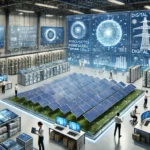The world is dealing with the harmful effects of climate change and the diminishing supplies of oil and gas. Now is the time to chase after energy that can last. New ways to get power from the sun and wind are pushing us to a future that won’t hurt our planet. But there’s more out there than just these two. This piece digs into the newest jumps in sun and wind power, and also looks at new tech that might change how we get our energy.
The Solar Revolution: Harnessing the Power of the Sun
Solar power has seen rapid growth due to better technology and lower costs. While traditional solar panels are the main method of capturing sunlight, new advancements are improving how we use solar energy.
Advances in Photovoltaic Technology
- Improved Efficiency: Multi-layer cells and special crystals enhance the efficiency of solar panels. These multi-layer cells capture different types of sunlight, reaching over 40% efficiency. The new crystals offer a cheaper alternative that could surpass traditional silicon cells in the future.
Solar Energy Storage Solutions
- Energy Storage: Solar power isn’t always available, as it relies on sunlight. Improved storage solutions like lithium-ion and solid-state batteries are addressing this issue. They store excess energy during the day for use at night or on cloudy days, ensuring a steady and reliable power supply.
Solar Innovations in Architecture
- Building-Integrated Photovoltaics (BIPV): BIPV combines design with renewable energy by integrating solar panels into building materials like windows, walls, and roofs. This reduces energy consumption and enhances the aesthetics of urban areas.
Wind Energy: Capturing the Power of the Wind
Wind power is a key part of the clean energy mix. Wind turbines convert wind energy into electricity, and advancements in technology are making them more efficient and versatile.
Offshore Wind Farms
- Offshore Advantage: Offshore wind farms are becoming more popular because they capture stronger and more consistent winds. These farms generate significant power without the space limitations of onshore sites. Floating wind turbines expand the potential of offshore wind energy, allowing placement in deeper waters with faster winds.
Advanced Turbine Designs
- Innovative Turbines: Modern wind turbines feature taller towers and larger blades to capture more wind energy. Vertical-axis wind turbines (VAWTs) and bladeless designs are emerging. VAWTs can operate in turbulent winds and fit better in urban settings, while bladeless turbines vibrate to generate energy, reducing noise and maintenance costs.
Integration with Energy Grids
- Smart Grids: Integrating wind energy into existing power grids requires advanced control technology. Smart grids and improved weather forecasting tools ensure a reliable and consistent energy supply by accurately predicting wind patterns and adjusting energy distribution accordingly.
Beyond Solar and Wind: Emerging Renewable Technologies
While solar and wind dominate the renewable energy landscape, other technologies are making strides towards a sustainable future. These emerging innovations provide diverse solutions to our energy needs.
Hydroelectric Power
- Modern Hydropower: Traditional hydropower remains a major source of clean energy, but new developments are making it more efficient and environmentally friendly. Small-scale hydropower systems and eco-friendly turbines generate electricity with minimal impact on the environment. Pumped-storage hydropower efficiently stores energy by moving water uphill when demand is low and releasing it to generate power when needed.
Geothermal Energy
- Harnessing Earth’s Heat: Geothermal energy taps into the Earth’s heat to generate power. Enhanced Geothermal Systems (EGS) use advanced drilling techniques to access deeper, hotter regions of the Earth, offering a significant source of clean energy, especially in areas with high geothermal activity.
The Role of Policy and Investment
The advancement of renewable energy technologies is heavily influenced by policy and investment decisions. Governments and private sector stakeholders play crucial roles in funding research and development, providing incentives for adoption, and creating regulatory frameworks that support the growth of renewables.
Conclusion: A Sustainable Future
New advances in clean energy are paving the way for a sustainable and resilient energy future. Solar and wind energy are leading the charge with significant improvements in efficiency and integration into power grids. Emerging technologies like geothermal, hydropower, biomass, and marine energy complement these efforts, offering diverse solutions to our energy needs. As policy and investment continue to support these innovations, we move closer to a world powered by clean, renewable energy.
















